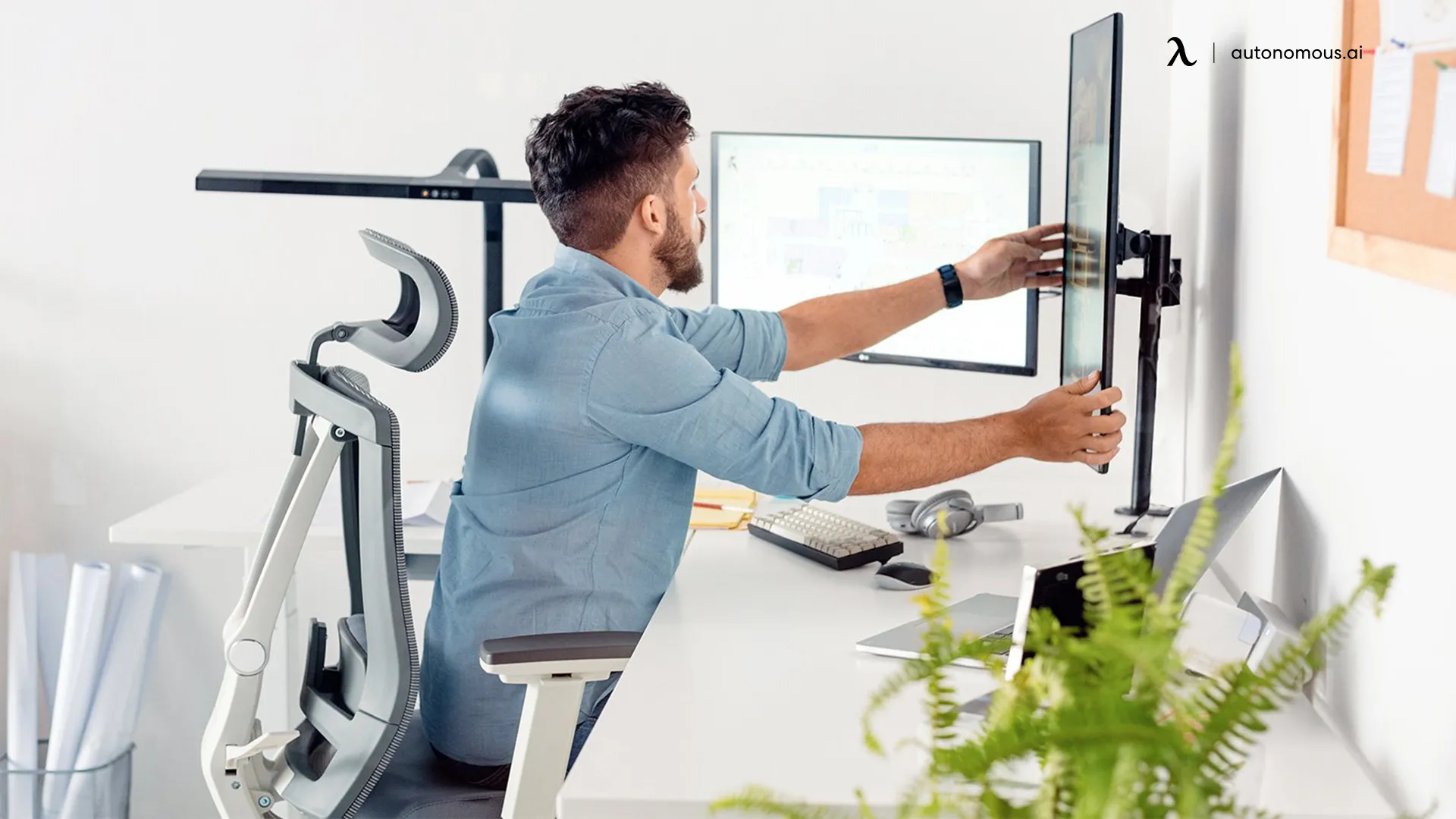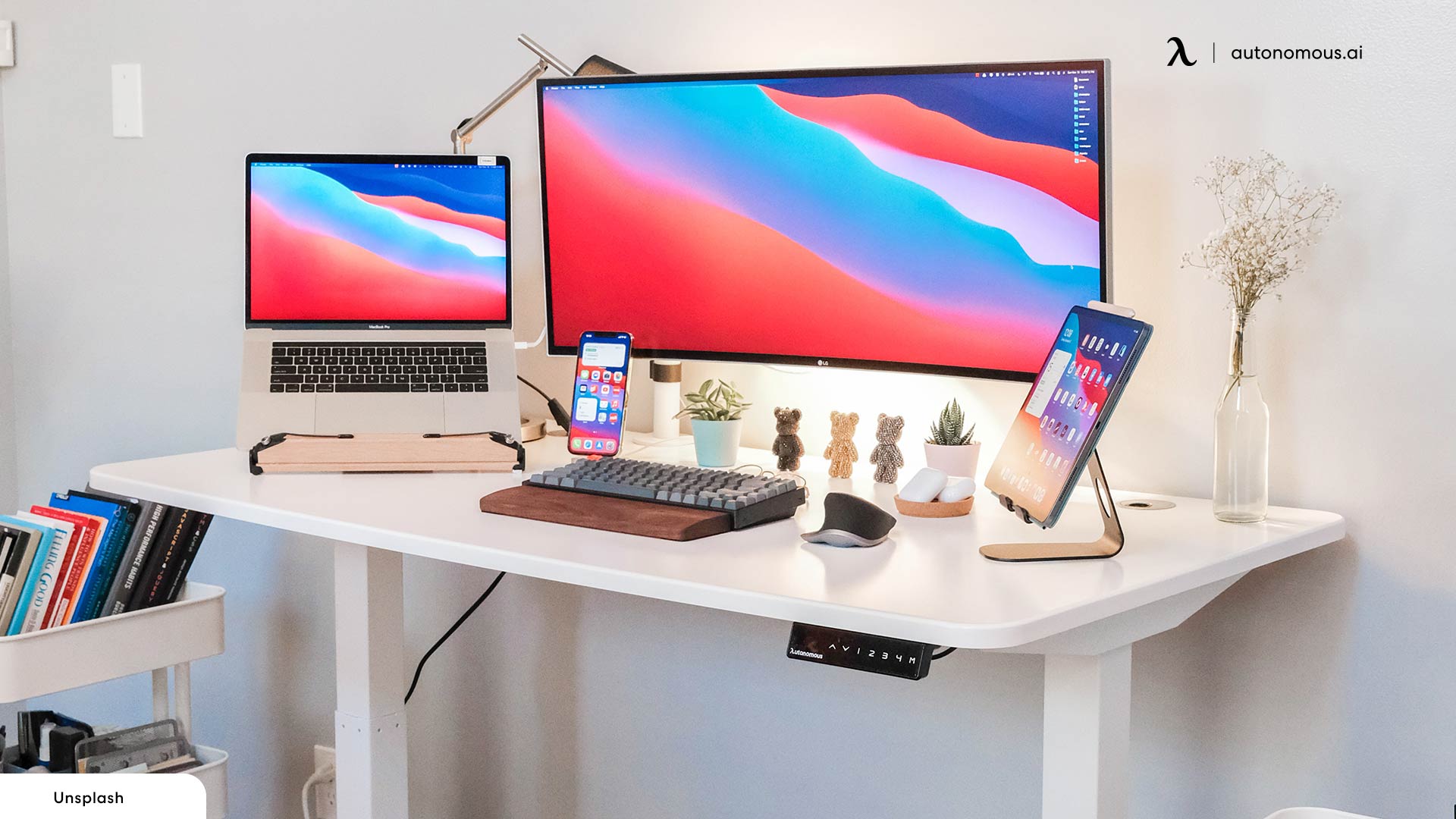
Table of Contents
Whether you’re working from home or setting up a more productive work environment, learning how to connect a laptop to a PC monitor can make a big difference. Adding a second screen gives you more room to multitask, edit, design, or simply stay organized.
No matter your device or display type, connecting them usually takes just a few minutes. In this guide, we’ll walk you through clear steps and practical tips to get your monitor working with your laptop smoothly.
Why Should You Connect Your Laptop to Your Desktop Computer?
Before we dive into the technical aspects, let's discuss the benefits of connecting your laptop to your desktop computer.
This setup can enhance your productivity, provide more screen real estate, and even improve your overall work-life balance. Here are three reasons why you might want to consider connecting your devices:
- Increased Productivity: With two screens or a vertical monitor setup, you can have different applications open at the same time, allowing you to multitask more efficiently.
- Improved Organization: Knowing how to connect a PC to a laptop can keep your workspace organized. In turn, this can reduce clutter and minimize the need for two or more devices.
- Enhanced Collaboration: If you work with many teammates, connecting your devices can enable collaboration and communication, making it easier to share files and ideas.
How To Connect A Laptop To A PC Monitor
Getting your laptop connected to a PC monitor is easier than most people think—it’s really about knowing which ports to use and how to configure your display settings. Whether you’re using a cable or going wireless, these practical steps will walk you through exactly how to connect a laptop to a PC monitor quickly and correctly.
Step 1: Check The Ports On Your Devices
Start by identifying which ports your laptop and monitor have. Common options include HDMI, USB-C, DisplayPort, and the older VGA or DVI. If both devices have the same port type, you can connect them directly with a single cable.
If they don’t match, you may need a simple adapter or a docking station to bridge the connection. This quick check ensures your setup goes smoothly without last-minute surprises.
Step 2: Choose The Best Connection Method
There are several reliable ways to hook up your laptop to a monitor:
- HDMI Cable: The easiest and most common way to connect a laptop to a computer monitor is. HDMI transmits both audio and video, making it ideal for a simple, high-quality setup.
- USB-C or Thunderbolt: Many modern laptops support video output through USB-C. If your monitor has a USB-C input, you can connect it directly. If not, use a USB-C to HDMI or DisplayPort adapter.
- DisplayPort: A strong choice for high-resolution or multi-monitor setups. DisplayPort offers excellent refresh rates and image quality.
- Docking Station: Perfect if your laptop has limited ports. A docking station or hub lets you connect your monitor and other accessories through one device.
- Wireless Display (Miracast, Chromecast, AirPlay): A good option if you prefer a cable-free desk. Just make sure both devices support wireless casting to avoid lag or signal drop.
- VGA or DVI: If you’re using an older monitor, these ports still work well for basic display needs. You may need an adapter to pair them with newer laptops.
Choosing the right connection depends on your laptop’s capabilities, the monitor’s ports, and the quality you want from your display.

Step 3: Plug In and Power On
Once you’ve picked your connection method, power off both devices before plugging in the cable or docking station.
Connect the laptop and monitor, then turn them back on. If the monitor doesn’t display anything right away, use the input/source button on the monitor to select the correct port (HDMI, DisplayPort, or VGA). In most cases, the image appears automatically once the signal is detected.
Step 4: Configure Display Settings
After the physical connection is made, adjust your display settings to get the view you want.
- On Windows, press Windows + P to switch between Extend, Duplicate, or Second screen only.
- On macOS, go to System Settings > Displays to manage screen arrangement and resolution.
Extending the display gives you more workspace, while mirroring shows the same content on both screens.
This is also where you can tweak resolution and scaling for sharper text and images. If you’re using multiple monitor, arrange their order to match your physical setup so your mouse moves naturally between screens.
With these steps, you’ve completed the process of how to hook up a laptop to a computer monitor—whether it’s through HDMI, USB-C, DisplayPort, or a wireless connection. A proper setup not only improves productivity but also creates a more comfortable and organized workspace.

Wireless & Docking Options
While wired connections like HDMI or USB-C are the most common, there are times when going wireless or using a docking station can help you connect your laptop to the PC monitor setup cleanly and flexibly. These methods are especially useful for minimal desk setups, flexible workspaces, or multi-monitor workflows.
1. Wireless Display Connection
If your laptop and monitor both support wireless display technology, you can mirror or extend your screen without using a cable.
- Miracast (Windows) and AirPlay (Mac) work well for casting your display directly to a wireless-enabled monitor or TV.
- If your monitor doesn’t have built-in wireless support, you can use a Chromecast dongle or a similar receiver.
- Keep both devices on the same Wi-Fi network and select the display option from your laptop’s settings to start casting.
This method is great for presentations, light multitasking, or clean desk aesthetics. However, wireless connections can sometimes lag, so they’re not always ideal for graphics-intensive work.

2. Docking Station or Hub
A docking station is one of the most versatile ways to connect a laptop to a desktop PC and multiple monitors.
- With just one cable plugged into your laptop, you can instantly connect displays, external drives, keyboards, and other peripherals.
- Most modern docking stations support multiple 4K monitors through HDMI or DisplayPort.
- This option is especially useful if your laptop has limited ports or you want to avoid constantly plugging and unplugging cables.
Docking stations are ideal for permanent or semi-permanent workstations, where ease of use and reliable connections matter most.
Troubleshooting Common Problems
Even when you know exactly how to connect a laptop to a PC monitor, issues can still pop up. Most of these problems are easy to fix once you know where to look. Here are some of the most common connection issues and what you can do to solve them quickly.
1. “No Signal” or Black Screen
If your monitor says “No Signal” after you’ve plugged everything in, start with the basics:
- Double-check that the cable is securely connected to both the laptop and the monitor.
- Make sure the monitor is set to the correct input source (HDMI, USB-C, DisplayPort, or VGA).
- Try restarting both devices to refresh the connection.
- If possible, test the cable with another device to rule out a faulty wire.
2. Adapter or Docking Station Not Recognized
If you’re using an adapter or docking station and nothing shows up, try:
- Unplugging and reconnecting it firmly.
- Updating your laptop’s display drivers or firmware.
- Use a different port if available.
- Checking the adapter’s compatibility—some USB-C hubs don’t support video output, so make sure yours does.

3. Wrong Resolution or Blurry Display
A mismatch in resolution between your laptop and monitor can make text or images look fuzzy.
- Go to your display settings and manually set the resolution to match your monitor’s native resolution.
- If you’re extending the display, adjust scaling for better clarity.
- Update your graphics drivers if the correct resolution options don’t appear.
4. Wireless Display Lag or Dropout
If you’re using Miracast, Chromecast, or AirPlay, you might notice occasional delays or signal drops.
- Place your laptop and monitor closer to your Wi-Fi router to improve signal strength.
- Avoid streaming heavy content in the background while casting.
- If the lag continues, switch to a wired connection like HDMI or USB-C for a more stable experience.
5. Laptop Detects Monitor but No Display
Sometimes, your laptop connected to a PC monitor will show up in settings, but nothing displays.
- Try duplicating instead of extending to see if the signal pushes through.
- Disconnect any other external displays that might be causing conflicts.
- Disable and re-enable the display in your settings to force a refresh.
Most display issues come down to loose connections, incompatible adapters, or incorrect settings. By going through these simple checks, you can get your screen up and running without needing extra tools or tech support.

Ergonomic & Productivity Tips For A Smarter Dual-Screen Setup
Knowing how to connect a laptop to a PC monitor is just the beginning. The real game changer is how you use that extra screen to work smarter. A thoughtful and minimalist desk setup can keep you focused, reduce strain, and make your desk feel less like clutter and more like a workspace designed for you.
Here are a few fresh, practical tips to make the most out of your dual monitor setup.
- Designate Screen Roles
Instead of splitting tasks randomly, assign each screen a clear purpose. For example, keep your main work (editing, writing, coding, design) on the external monitor, and use your laptop for reference, chat apps, or real-time updates. This reduces constant window switching and keeps your workflow clean.
- Build Natural Workflow Zones
Think of your desk as having different zones. The monitor is your main focus zone, your laptop acts as your support zone, and any extra office accessories or notebooks live outside that core area. This subtle structure reduces desk chaos and makes multitasking smoother.
- Use Vertical Screen Space Strategically
If your monitor can rotate, try turning it vertically for reading documents, reviewing code, or following long threads. Vertical orientation helps reduce scrolling and can keep your posture more neutral since your eyes move less side-to-side.

- Calibrate Displays for Consistency
When using two different screens, colors and brightness often don’t match. Take a minute to align them. Matching display temperature and brightness reduces eye strain and creates a seamless transition when dragging windows from one screen to another.
- Keep Your Cables in Check
Cable clutter can easily ruin a clean setup. By using simple and effective cable management solutions, such as cable trays, under-desk drawers, you can help keep everything organized, making it easier to adjust your screens or move your laptop without a mess.
Use the Right Monitor Support
Adjustable arms make a big difference in posture and comfort. A monitor arm lets you fine-tune height and angle, keeping your external display at eye level and reducing neck and shoulder strain.
- Keep It Flexible, Not Fixed
Don’t lock yourself into a single layout. If your day involves different kinds of work, rearrange the angle of your laptop connected to a PC monitor to match what you’re doing. A more dynamic setup keeps your body from stiffening and helps maintain focus over long hours.
These subtle adjustments don’t require expensive gear—just smart positioning and intentional setup. A dual-screen layout that fits your workflow can quietly boost focus, energy, and overall productivity.

FAQs
1. How to connect a laptop to a PC monitor without HDMI?
You can connect a laptop to a PC monitor without HDMI by using USB-C, DisplayPort, VGA, or DVI cables. If your monitor doesn’t support these ports, use an adapter or a wireless display option like Miracast, Chromecast, or AirPlay. Once connected, select the correct input on the monitor to display your screen.
2. How do you connect a laptop to a PC monitor and use both screens?
To use both screens, connect the monitor to your laptop using a cable or wireless option, then enable Extend Display. On Windows, press Windows + P and select Extend; on macOS, go to System Settings > Displays. This lets you work on two screens simultaneously for better multitasking.
3. Can I connect my laptop and PC to one monitor?
Yes. You can connect a laptop and a desktop PC to one monitor if it has multiple input ports, such as HDMI and DisplayPort. Plug each device into a separate port and switch between them using the monitor’s input/source button. Some monitors also support PiP or PbP to display both devices at once.
4. How to hook up a laptop to a computer monitor and set it as the primary display?
Connect the laptop to the monitor using the right cable or dock, then in system settings set the monitor as the “main display” so ribbons, taskbars, and windows open there by default.
5. How do I connect my monitors to my laptop when I have multiple external monitors?
Use a laptop with multiple video-out ports or a docking station to support all monitors; connect each monitor to the output ports, then go to display settings to arrange them and enable “Extend” mode for each screen.

Final Words
Learning how to connect a laptop to a PC monitor can completely change the way you work, study, or create. Whether you’re using HDMI, USB-C, DisplayPort, a docking station, or even a wireless display, the process is simple and flexible for almost any setup. A clear, stable connection gives you more room to work without constantly juggling between windows.
From quick plug-and-play connections to multi-monitor layouts, choosing the right method depends on your ports, workspace style, and performance needs. As your setup grows, adding more screens or linking devices can make it even more versatile. Guides on how to make a 4-monitor setup and how to connect 2 laptops, offering different ways to build on this foundation and adapt your workspace to fit more complex workflows.
With the right setup, your laptop and monitor can work together seamlessly to boost both productivity and comfort.
.svg)







